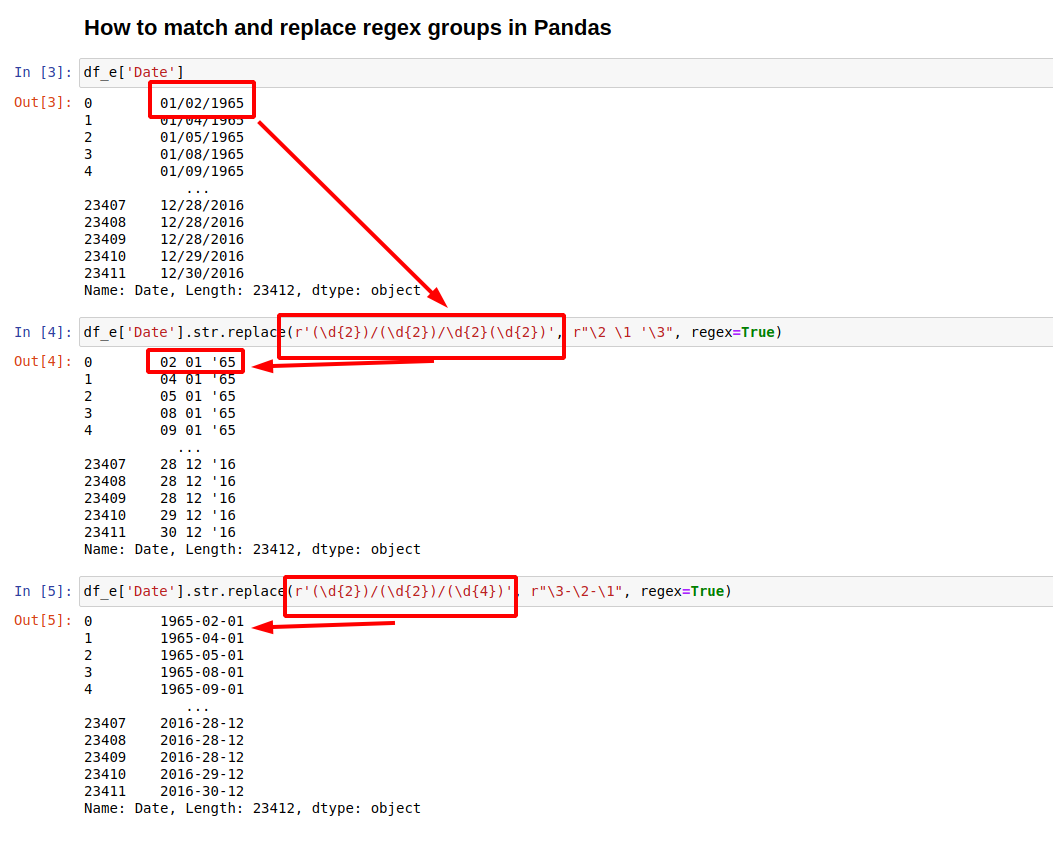In this short tutorial, we'll look at how to match and replace regex groups in Pandas.
Here you can find the short answer:
df_e['Date'].str.replace(r'(\d{2})/(\d{2})/(\d{4})', r"\3-\2-\1", regex=True)
How to match and replace regex groups in Pandas
Let's check first for the regex pattern r'(\d{2})/(\d{2})/(\d{4})'. It has 3 capturing groups::
- 1st capturing group
(\d{2})\d- matches a digit (equivalent to [0-9])- {2} matches the previous token exactly 2 times
- 2nd capturing group
(\d{2})\d- matches a digit (equivalent to [0-9])- {2} matches the previous token exactly 2 times
- 4nd capturing group
(\d{4})\d- matches a digit (equivalent to [0-9])- {4} matches the previous token exactly 4 times
Between the capturing groups there are separators - / which will be matched but not captured.
Now in the replacement part - r"\3-\2-\1" - the groups are presented by numbers - starting from 1:
- 1st group is
\1 - 2nd group is
\2 - 3rd group is
\3
So if the initial value in Pandas column is:
0 01/02/1965
1 01/04/1965
2 01/05/1965
3 01/08/1965
4 01/09/1965
After the replacement we will end with:
0 1965-02-01
1 1965-04-01
2 1965-05-01
3 1965-08-01
4 1965-09-01
Another example is:
df_e['Date'].str.replace(r'(\d{2})/(\d{2})/\d{2}(\d{2})', r"\2 \1 '\3", regex=True)
result will be:
0 02 01 '65
1 04 01 '65
2 05 01 '65
3 08 01 '65
4 09 01 '65

How to match and replace regex groups - string patterns
Let's have string data which has a different number of words. Suppose we like to extract only the last word from all rows:
0 Noida
1 Noida
2 Work From Home
3 Work From Home
4 Work From Home
...
We can use regex groups to match the last word by:
df['location'].str.replace(r'(.*) (.*) (.*)', r"\3", regex=True)
result:
0 Noida
1 Noida
2 Home
3 Home
4 Home
If you need to work with special characters and complex expressions - you may need to test a lot - in order to avoid problems.
Let's have data like:
0 Software Testing
1 Java, SQL, Unix, Oracle, MS SQL Server, Hibern...
2 English Proficiency (Spoken), English Proficie...
3 HTML, CSS, Flask, Python, Django
4 HTML, CSS, JavaScript, ReactJS, Redux
For example if you expect:
df['skills'].str.replace(r'(.*)(\(.*\))(.*)', r"\1\3", regex=True)
The regex above to remove all words surrounded by ( and ) - this will not happen:
0 Software Testing
1 Java, SQL, Unix, Oracle, MS SQL Server, Hibern...
2 English Proficiency (Spoken), English Proficie...
3 HTML, CSS, Flask, Python, Django
4 HTML, CSS, JavaScript, ReactJS, Redux
because the regex are greedy by default and will try to match as much as possible. You can check what is captured as group 2:
df['skills'].str.replace(r'(.*)(\(.*\))(.*)', r"\2", regex=True)
So as you can if there are multiple matches - the regex will try to match everything until the end - or matching the last one possible:
0 Software Testing
1 (Java)
2 (Written)
3 HTML, CSS, Flask, Python, Django
4 HTML, CSS, JavaScript, ReactJS, Redux
For non greedy matching in Pandas regex groups you can add ?. So:
(.*)- greedy match(.*)- non greedy match
df['skills'].str.replace(r'(.*?)(\(.*?\))(.*)', r"\2", regex=True)
result:
0 Software Testing
1 (Java)
2 (Spoken)
3 HTML, CSS, Flask, Python, Django
4 HTML, CSS, JavaScript, ReactJS, Redux
Note that the third line changed from (Written) to (Spoken).
How to match and replace regex groups - numeric patterns
Suppose we have ranged amounts like:
0 8000 /month
1 10000 /month
2 1000-2000 /month
3 1000-2000 /month
4 1000-2000 /month
And we need to get only the upper amount from this range and leave the rest as it is. This can be achieved by:
df['stipend'].str.replace(r'(\d+)-(\d+)(.*)', r"\2\3", regex=True)
result:
0 8000 /month
1 10000 /month
2 2000 /month
3 2000 /month
4 2000 /month









